Abstract
Isoniazid is widely used to treat tuberculosis. In populations with a high prevalence rate of tuberculosis, acute ingestion of isoniazid has been reported as a potential cause of coma. In this study, we present the diagnosis and treatment of isoniazid poisoning in a case with acute coma as the major clinical presentation.
A 32-year-old male who ingested 12 g isoniazid (2 hours prior to medical attention) was brought to the emergency department while in a coma and experiencing frequent seizures. Initial treatment with large doses of pyridoxine (for 6 hours) failed to awaken this patient. The patient was then given hemodialysis and pyridoxine; after 3 days he awoke from coma, with no further reported seizures.
Isoniazid poisoning should be suspected in patients whose major symptoms are coma and seizure, especially those who have access to isoniazid. Monitoring the blood level of isoniazid will establish the diagnosis and help clinical management. A combination of hemodialysis and pyridoxine is effective in treating isoniazid poisoning.
Similar content being viewed by others
References
Shannon MW, Lovejoy FH Jr. Isoniazid. In: Haddad LM, Winchester JF, eds. Clinical Management of Poisoning and Drug Overdose. 2nd edition. Philadelphia: Saunders; 1990:970–975.
Alvarez FG, Guntupalli KK. Isoniazid overdose: four case reports and review of the literature. Intensive Care Med. 1995;21:641–644.
Wood JD, Peesker SJ. The effect on GABA metabolism in brain of isonicotinic acid hydrazide and pyridoxine as a function of time after administration. J Neurochem. 1972;19:1527–1537.
Pearl PL, Gibson KM. Clinical aspects of the disorders of GABA metabolism in children. Curr Opin Neurol. 2004;17:107–113.
Orlowski JP, Paganini EP, Pippenger CE. Treatment of a potentially lethal dose isoniazid ingestion. Ann Emerg Med. 1988;17:73–76.
Siefkin AD, Albertson TE, Corbett MG. Isoniazid overdose: pharmacokinetics and effects of oral charcoal in treatment. Hum Toxicol. 1987;6:497–501.
Temmerman W, Dhondt A, Vandewoude K. Acute isoniazid intoxication: seizures, acidosis and coma. Acta Clin Belg. 1999;54:211–216.
Wason S, Lacouture PG, Lovejoy FH Jr. Single high dose pyridoxine treatment for isoniazide poisoning. JAMA. 1981;246:1102–1104.
Lheureux P, Penaloza A, Gris M. Pyridoxine in clinical toxicology: a review. Eur J Emerg Med. 2005;12:78–85.1989;69:292–296.
Author information
Authors and Affiliations
Corresponding author
Rights and permissions
About this article
Cite this article
Tai, WP., Yue, H. & Hu, PJ. Coma caused by isoniazid poisoning in a patient treated with pyridoxine and hemodialysis. Adv Therapy 25, 1085–1088 (2008). https://doi.org/10.1007/s12325-008-0098-7
Published:
Issue Date:
DOI: https://doi.org/10.1007/s12325-008-0098-7




